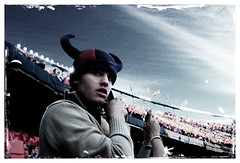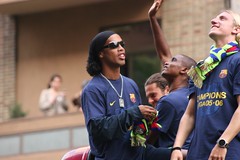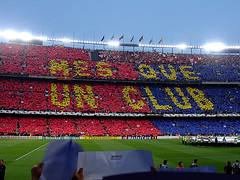Early years (1899-1908)
On 22 October 1899 Joan Gamper placed an advert in Los Deportes declaring his wish to form a football club. A positive response resulted in a meeting at the Gimnasio Sole on November 29. Eleven players attended: Gualteri Wild, Lluís d'Ossó, Bartomeu Terradas, Otto Kunzle, Otto Maier, Enric Ducal, Pere Cabot, Carles Pujol, Josep Llobet, John Parsons, and William Parsons. As a result Foot-Ball Club Barcelona was born. Several other Spanish football clubs, most notably Real Madrid and Athletic Bilbao, also had British founders, and as a result they initially adopted English-style names.
FC Barcelona quickly emerged as one of the leading clubs both Catalonia and Spain as they competed in both the Campionat de Catalunya and the Copa del Rey. In 1901 they won their first trophy when they won the Copa Macaya and in 1902 they also played in the first Copa del Rey final, losing 2-1 to Club Vizcaya.
The Gamper years (1908-1925)
In 1908 Joan Gamper became club president for the first time. Gamper took over the presidency as the club was on the verge of folding. The club had not won anything since the Campionat de Catalunya of 1905 and its finances suffered as a result. Gamper was subsequently club president on five separate occasions between 1908 and 1925 and spent 25 years at the helm. One of his main achievements was to help Barça acquire its own stadium. On March 14 1909, it moved into the Carrer Industria, a stadium with a capacity of 6,000. Gamper also launched a campaign to recruit more club members and by 1922 the club had over 10,000. This led to the club moving again, this time to Les Corts. This stadium had an initial capacity of 20,000, later expanded to an impressive 60,000.
Gamper also recruited Paulino Alcántara, the club's all time top-scorer with 356 goals, and in 1917 appointed Jack Greenwell as manager. This saw the club's fortunes begin to improve on the field. During the Gamper era FC Barcelona won eleven Campionat de Catalunya, six Copa del Rey and four Coupe de Pyrenées and enjoyed its first golden age. As well as Alcántara the Barça team under Greenwall also included Sagibarbá, Ricardo Zamora, Josep Samitier, Félix Sesúmaga and Franz Platko.
CF Barcelona (1940-1973)
After the Spanish Civil War, the Catalan language and flag were banned and football clubs were prohibited from using non-Spanish names. These measures led to the club having its name forcibly changed to Club de Fútbol Barcelona and the removal of the Catalan flag from the club shield. During the Franco era one of the few places that Catalan could be spoken freely was within the club's stadium. Despite these restrictions, CF Barcelona enjoyed considerable success during the 1940s and 1950s.
In 1945, with Josep Samitier as coach and players like César, Ramallets and Velasco, they won La Liga for first time since 1929. They added two more titles in 1948 and 1949. In 1949 they also won the first Copa Latina. Coach Fernando Daucik and Ladislao Kubala, regarded by many as the club's best ever player, inspired the team to five different trophies including La Liga, the Copa del Generalisimo, the Copa Latina and the Copa Eva Duarte in 1952. In 1953 they helped the club win La Liga and the Copa del Generalisimo again. The club also won the Copa del Generalisimo in 1957 and the Fairs Cup in 1958.
With Helenio Herrera as coach, a young Luis Suárez, the European Footballer of the Year in 1960, and two influential Hungarians recommended by Kubala, Sándor Kocsis and Zoltán Czibor, the team won another national double in 1959 and a La Liga/Fairs Cup double in 1960. In 1961 they became the first club to beat Real Madrid in a European Cup game, thus ending their monopoly of the competition.
The 1960s were less successful for the club, with Real Madrid and Atlético Madrid monopolising La Liga. The completion of the Camp Nou, finished in 1957, meant the club had little money to spend on new players. However the decade also saw the emergence of Josep Fusté and Carles Rexach and the club winning the Copa del Generalisimo in 1963 and the Fairs Cup in 1966. Barça restored some pride by beating Real Madrid 1-0 in the 1968 Copa del Generalisimo final at the Bernabéu. The club changed its official name back to Futbol Club Barcelona in 1974.[1]
Development of the rivalry with Real Madrid
There is often a fierce rivalry between the two strongest teams in a national league and this is particularly the case in La Liga, between FC Barcelona and Real Madrid. From the start the clubs were seen as representatives of the two rival regions of Spain, Catalonia and Castile, as well as of the two cities themselves. The rivalry reached a new level during the Franco years (1939 - 1975) when Real Madrid`s success in the European Cup convinced Franco (who favoured Atlético Madrid, then renamed Atlético Aviación, during his first years in power) to provide institutional support for Real Madrid in order to create a sporting embodiment able to successfully represent Spain (and therefore his own regime) in Europe.
However, during the Spanish Civil War itself members of both clubs suffered at the hands of Franco supporters. FC Barcelona president Josep Sunyol was murdered while Real Madrid president Rafael Sánchez Guerra, a prominent Republican, was imprisoned and tortured. They also arrested and murdered a Madrid vice-president and club treasurer and an acting president disappeared. In 1940 Enric Piñeyro, a Franco collaborator, was appointed FC Barcelona president. The rivalry with Madrid intensified further after the 1943 Copa del Generalísimo semi-final between the two clubs. The first leg at Les Corts ended in a 3-0 victory to Barça, but the return leg saw them defeated 11-1. It has been alleged by some that the FC Barcelona players were pressured into losing the game and even Pineyro resigned in protest. The rivalry with Madrid was exacerbated significantly in the 1950s by the dispute over Alfredo Di Stéfano.
The arrival of Cruyff
The 1973/74 season saw the arrival of a new Barça legend – Johan Cruyff. Already an established player with Ajax, Cruyff quickly won over the Barça fans when he told the European press he chose Barça over Real Madrid because he could not play for a club associated with Franco. He further endeared himself when he chose a Catalan name, Jordi, for his son. He helped the club win La Liga for the first time since 1960, along the way defeating Real Madrid 5-0 at the Bernabéu. He was also crowned European Footballer of the Year twice in a row while at club.
The Nuñez years
1978-1988
Josep Lluís Nuñez was elected president of FC Barcelona in 1978. His main objectives were to establish Barça as a world-class sports club and to give the club financial stability.
In 1979 and 1982 the club won two of four European Cup Winners' Cups won in the Nuñez era. In 1982 Diego Maradona was signed for a world record fee from Boca Juniors. However his time with Barça was short-lived and unsuccessful and he soon left for Napoli. In 1985 under Terry Venables Barça won La Liga and in 1986 he took the team to their second European Cup final, only to lose on penalties to Steaua Bucureşti.
The Dream Team
In 1988 Johan Cruyff returned to the club as manager, assembling the so-called Dream Team, named after the US basketball team that played at the 1992 Summer Olympics hosted by Barcelona. He introduced players like Josep Guardiola, José Mari Bakero, Txiki Beguiristáin, Goikoetxea, Ronald Koeman, Michael Laudrup, Romário and Hristo Stoichkov. This team won La Liga four times between 1991 and 1994 and beat Sampdoria in both the 1989 UEFA Cup Winners' Cup final and the 1992 European Cup final at Wembley. They also won a Copa del Rey in 1990, the European Super Cup in 1992 and three Supercopa de España. With 11 trophies, Cruyff has been the club's most successful manager to date. He is also the club's longest serving manager. However, in his final two seasons, he failed to win any trophies and fell out with Josep Lluís Nuñez. This resulted in his departure.
1996-2000
Cryuff was briefly replaced by Bobby Robson who took charge of the club for a single season in 1996/97. He recruited Ronaldo from his previous club, PSV Eindhoven and delivered a cup treble winning the Copa del Rey, UEFA Cup Winners Cup and the Supercopa de España. Among Robson’s non-playing staff was José Mourinho, who assisted with training and acted as translator.
Despite his success, Robson was only ever seen as a short-term solution while the club waited for Louis van Gaal to become available. Like Maradona, Ronaldo only stayed a short time and he left for Internazionale. However, new heroes such as Luís Figo, Luis Enrique and Rivaldo emerged and the team won a Copa del Rey/La Liga double in 1998. In 1999 they retained the La Liga title and Rivaldo became the fourth Barça player to be awarded European Footballer of the Year. Despite this domestic success, the failure to emulate Real Madrid in the UEFA Champions League led to Van Gaal and Nuñez resigning in 2000.
Gaspart years (2000-2003)
The departures of Nuñez and Van Gaal were nothing compared to that of Luís Figo. As well as club captain, Figo had become a cult hero and was considered by Catalans to be one of their own. It is widely believed that his dislike of the new president, Joan Gaspart, triggered his departure for arch-rivals Real Madrid. The Barça fans were distraught by Figo’s decision to join Real and during subsequent visits to the Camp Nou Figo was given an extremely hostile reception, including one occasion when a pig's head was thrown at him from the crowd. The next three years saw the club in decline and managers came and went, including a short second spell by Louis van Gaal. Gaspart did not inspire confidence off the field either and in 2003 he and Van Gaal resigned.
The current era
After the disappointment of the Gaspart era, a combination of a new young president Joan Laporta and a relatively young new manager Frank Rijkaard saw the club bounce back. On the field an influx of talented players, such as Ronaldinho, Deco, Ludovic Giuly, and Samuel Eto'o, and experienced professionals, such as Henrik Larsson, Rafael Márquez and Giovanni van Bronckhorst combined with a nucleus of home grown players, Carles Puyol, Andrés Iniesta, Xavi, Lionel Messi and Víctor Valdés saw the club return to success. Barça won La Liga/Supercopa de España doubles in both 2005 and 2006. In 2006 they also won the UEFA Champions League.
For the 2006/07 season, FC Barcelona has been reinforced with the arrival of Eidur Gudjohnsen, Gianluca Zambrotta, Lilian Thuram, and the return of Javier Saviola.
On 14 July 2006 the club announced a five year agreement with UNICEF, which includes having the UNICEF logo on their shirts. The agreement will see FC Barcelona donating US$1.9 million per year to UNICEF, and rejecting significant commercial offers to be the first shirt sponsor of the football team.
They took part in the FIFA Club World Cup 2006, making it to the final, only to be beaten by a late goal against Internacional.
My Favorites
History
Subscribe to:
Post Comments (Atom)











0 Comments:
Post a Comment